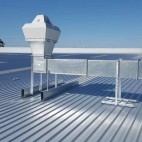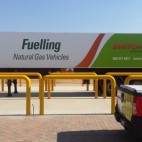The availability of energy is of great concern to human society. As fossil fuels are being depleted, there is a need to find new energy sources. At the same time, climate change has highlighted the impact of reckless consumption on the environment. As energy from biomass combustion plants is CO2 neutral and sustainable in an agricultural system it is therefore an attractive alternative energy source. Bio-energy is thus one of the largest sources of renewable energy amongst hydro-, geothermal-, solar- and wind energy.
Bagasse is a waste product from the sugar extraction process and globally it is common to use the thermochemical conversion of this material to power sugar mills and the peripheral communities. Located at Sezela on the south coast of KwaZulu-Natal, one of the largest sugar factories in South Africa is owned by Illovo and similarly burns bagasse to generate power. South Africa's newest mill is RCL Komati in Mpumalanga. Amongst a wide variety of fibrous fuels used worldwide, bagasse forms a large part of the pool and it was, therefore, chosen for a research project on biomass combustion. RCL Komati was used as a case study.
Combustion involves turbulent fluid flow, chemical reaction, heat transfer and other complicated physical and chemical processes, especially when solid fuels are burnt. Computational Fluid Dynamics (CFD) lends itself very well to the modelling of combustion and integrates the understandings in combustion fundamentals in the best possible way. It is a powerful and cost-effective tool in the design and optimisation of combustion processes. A model of a bagasse-fired boiler at RCL Komati was developed by John Thompson using the commercial CFD software package ANSYS® Fluent. The simulation included the interaction between the particle and gas phase with basic chemistry, which suited the initial focus, namely, the heat transfer to a tube bank in the combustion zone.
The next part of the study shifted to the combustion process lower down in the furnace More detailed chemistry needed to be included in the combustion simulation in order to predict air-pollution emissions. Devolatilisation is the starting point of the combustion process and is especially important in a bagasse-fired boiler where flame stability plays a large role. The aforementioned aspects require advanced combustion and devolatilisation models, respectively, in order to implement higher order chemistry.
Due to the increased computational cost and numerical complexity associated with advanced models, another field of science, namely, Artificial Intelligence (AI), was combined with the central topic of combustion. AI is the study of computations that make it possible to perceive, reason and act. Machine learning is the science of programming computers to learn from data using statistical techniques and is a subset of artificial intelligence. Recent advances in this field makes it a suitable method to determine the relationship between variables in a multi-dimensional data space. It was therefore identified as the ideal technique for creating a reduced-order devolatilisation model.
Artificial Neural Networks (ANNs) were used to create the reduced-order model since this technique is frequently more accurate and adaptable than other machine learning algorithms on very large and complex problems. ANNs are inspired by biological neurons in the human and animal brain and are able to learn, self-organise and generalise. Generalisation is the ability to calculate outputs from inputs that have not been seen before based on previous experience.
A training algorithm adjusts the coefficients of the network during learning. The traditional modelling approach consists of a programmer with given inputs to a system, processing requirements and desired outputs. A set of step by step instructions are then followed to relate the inputs to outputs. ANNs do not require instructions, rules or relationships of data. ANNs determine the relationships between the inputs and outputs by looking at examples of input-output pairs, which is called learning. The ability to learn how to process the data to a desired outcome without a set of instructions is called self-organisation. The resulting formulation of devolatilisation is easier to implement and computationally more efficient compared with traditional ordinary differential equation solvers.
The composite industrial model developed by John Thompson can be used in new boiler design and plant modification. Other boiler design houses do not use the level of CFD simulation developed in this research as best practice. The norm is basic chemistry and devolatilisation models, although most boilers are designed with lumped parameter approaches.
As prevention of pollution emissions is becoming increasingly important, especially relating to NOx from bagasse firing, selective non-catalytic reduction (SNCR) is required. NOx contributes to the formation of acid rain, smog and also affects tropospheric ozone. SNCR involves injecting urea or ammonia into the combustion chamber where the gas is within a specific temperature range in order to reduce NOx. CFD is used for SNCR design by boiler companies, but the chemistry of the NOx reactions is rarely modelled. If it is modelled, it is only done so in a post-processor mode. Whereas the model developed in this case study couples the chemistry with the flow field in a computationally efficient manner and is therefore a significant contribution to the sugar industry, in particular.
John Thompson, a division of ACTOM (Pty) Ltd, designs, manufactures, installs, maintains and retro-fits fossil fuel- and biomass-fired industrial boilers for both local and international markets. With its principal focus on boiler and environmental solutions, the complete life cycle of bagasse-fired boilers is a core technology of the company. The application of CFD on power generation from boilers has been a large part of the research and development at John Thompson during the last 7 years.
Dr Philip du Toit Pr Eng
Senior Development Engineer
Industrial Watertube Boilers
John Thompson










